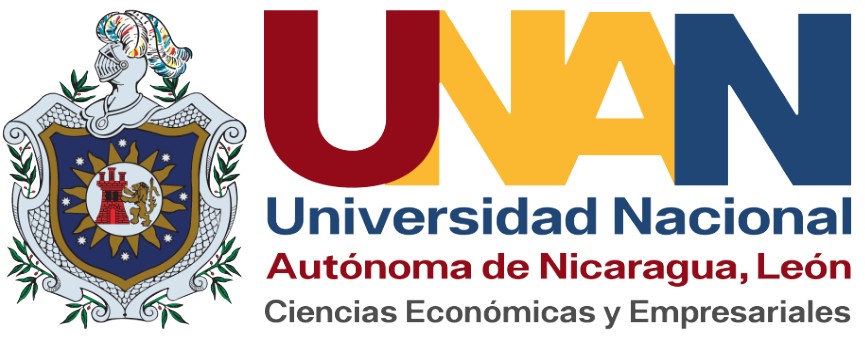Influencia de los ingresos femeninos y masculinos sobre el gasto en alimentos de los hogares Nicaragüenses
DOI:
https://doi.org/10.5377/aes.v4i1.16441Palabras clave:
ingresos, género, gastos en alimentos, curva de Engel, NicaraguaResumen
Otras investigaciones han explorado si los ingresos del hogar son utilizados de la misma manera dependiendo del género de la persona que los genere. Sin embargo, la mayoría de estos estudios no incluyen dentro del análisis a los hogares con múltiples miembros generadores de ingreso. Este trabajo intenta llenar este vacío en la literatura explorando los cambios en los gastos alimentarios de los hogares generados ante una variación en los ingresos de las mujeres frente a aquellos percibidos por los hombres, tanto en los hogares nucleares con dos generadores de ingresos como en los formados por múltiples miembros generadores de ingresos. Este estudio es exploratorio y utiliza la Encuesta de Medición del Nivel de Vida (EMNV) de Nicaragua de 2014 como fuente de información. Para ello, se estima una curva de Engel de alimentos, utilizando análisis de regresión, que integra la noción de coaliciones de intereses de género como parte de las variables demográficas. No se encontraron grandes diferencias entre las asignaciones del presupuesto del hogar destinado a alimentación frente a los cambios de los ingresos laborales generados por mujeres y hombres. Las características personales analizadas afectan de forma negativa el gasto en alimentación. Por el contrario, las características del hogar, i.e., número de personas generadoras de ingresos y área de residencia, son los principales determinantes del aumento de los gastos alimentarios del hogar. No se encontraron diferencias entre hogares nucleares y múltiples generadores de ingresos.
Descargas
Citas
Abdullah Yusof, S., & Duasa, J. (2010). Household decision-making and expenditure patterns of married men and women in Malaysia. Journal of Family and Economic Issue, 31 (3), 371-381. http://dx.doi.org/10.1007/s10834-010-9200-9
Aguilar-Lopez, A., González-Andrade, S., & Kuhar, A. (2020). Estimation of Engel curves for household expenditure on dry bean and processed bean in Mexico. Acta Agriculturae Slovenica, 115(2), 215–222. http://dx.doi.org/10.14720/aas.2020.115.2.1415
Alderman, H., Chiappori, P.-A., Haddad, L., Hoddinott, J., & Kanbur, R. (1995). Unitary versus Collective Models of the Household: Is It Time to Shift the Burden of Proof? The World Bank Research Observer, 10(1), 1–19. http://www.jstor.org/stable/3986564
Angelucci, M., & Garlick, R. (2014). Heterogeneity and Aggregation: Testing for Efficiency in Intra-household Allocation. [Unpublished Manuscript]. https://pdfs.semanticscholar.org/6cf0/8a9c58566f236a83a5f70d1c7b1275a5b17d.pdf?_ga=2.55313442.806988310.1589489800-847693442.1586881638
Armand, A., Attanasio, O., Carneiro, P., & Lechene, V. (2016). The effect of gender-targeted conditional cash transfers on housheold expenditures : evidence from a randomized experiment. The Economic Journal, 130(631), 1875-1897. https://doi.org/10.1093/ej/ueaa056
Attanasio, O., Battistin, E., & Mesnard, A. (2011). Food and cash transfers: evidence from Colombia. The Economic Journal, 122(559), 92-124. https://doi.org/10.1111/j.1468-0297.2011.02473.x
Attanasio, O., & Lechene, V. (2002). Tests of income pooling in household decision. Review of Economic Dynamics, 5(4), 720-748. https://doi.org/10.1006/redy.2002.0191
Attanasio, O., & Lechene, V. (2010). Conditional cash transfers, women and the demand for food (IFS Working Paper 10/17). Economic & Social Research Council. Retrieved from https://ifs.org.uk/sites/default/files/output_url_files/wp1017.pdf
Attanasio, O., & Lechene, V. (2014). Efficient responses to targeted cash transfers. Journal of Political Economy, 122(1), 178-222. https://doi.org/10.1086/674968
Bhupal, G. & Sam, A.G. (2014). Female income and expenditure on children: impact of the national rural employment guarantee scheme in India. Applied Econometrics and International Development, 14(2), 175-192.
Bircan Bodur, F. & Mukiyen Avcı, G. (2016). Household expenditure patterns: evidence from working-couple households in Turkey. International Review of Economics and Management, 3(2), 85-108. https://dergipark.org.tr/en/pub/iremjournal/issue/15723/293012
Bobonis, G.J. (2009). Is the allocation of resources within the household efficient? New evidence from a randomized experiment. Journal of Political Economy, 117(3), 453-503. https://doi.org/10.1086/600076
Bradshaw, S. (2013). Women’s decision-making in rural and urban households in Nicaragua: The influence of income and ideology. Environment and Urbanization, 25(1), 85–94. https://doi.org/10.1177/0956247813477361
Brillanti, C., Echeverria, L., & Berges, M.E. (2022, October). Consumo de alimentos y regresión por cuantiles [Food consumption and regression by quantiles]. Paper presented at the 53 Annual Meeting of the Asociación Argentina de Economía Agraria "Perspectivas del sector agroalimentario en la región y en el mundo", Bahía Blanca, Argentina.
Brossart, D.F., Parker, R.I., & Castillo, L.G. (2011). Robust regression for single-case data analysis: How can it help?. Behavior Research Methods, 43, 710–719. https://doi.org/10.3758/s13428-011-0079-7
Browning, M., Bourguignon, F., Chiappori, P., & Lechene, V. (1994). Income and outcomes: A structural model of intrahousehold allocation. Journal of Political Economy, 102(6), 1067-1096. https://doi.org/10.1086/261964
Chikobola, M. and Edriss, A. (2016) Estimation of rural-urban expenditure and elasticities of food items in Zambia: evidence from living conditions monitoring survey. Modern Economy, 7, 567-574. http://dx.doi.org/10.4236/me.2016.75062
De Backer, K., Holvoet, N., & Milanzi, M. (2021). Intrahousehold relationships and decision-making in extended households of the Luguru community. Journal of International Women’s Studies, 22(5), 57-71. https://vc.bridgew.edu/jiws/vol22/iss5/4
Djebbari, H. (2005). The Impact on Nutrition of the Intrahousehold Distribution of Power (IZA DP No. 1701). Bonn: IZA. Retrieved from http://ftp.iza.org/dp1701.pdf
Doss, C. (2001). Is risk fully pooled within the household? Evidence from Ghana.
Economic Development and Cultural Change, 50(1), 101-130. https://doi.org/10.1086/340009
Doss, C. (2006). The effects of intrahousehold property ownership on expenditure patterns in Ghana. Journal of African Economies, 15(1), 149-180. https://doi.org/10.1093/jae/eji025
Doss, C. (2013). Intrahousehold Bargaining and Resource Allocation in Developing Countries (WPS6337). The World Bank. Retrieved from http://documents.worldbank.org/curated/en/701071468155969077/pdf/wps6337.pdf
Elsas, S. (2013). Pooling and Sharing Incomes within Households: A Satisfaction Approach (SOEPpapers on Multidisciplinary Panel Data Research, No. 587). Berlin: German Socioeconomic Panel Studies.
Esteve, A., Castro-Martín, T., & Castro Torres, A.F. (2022). Families in Latin America: trends, singularities, and contextual factors. Annual Review of Sociology, 48, 485-505. http://dx.doi.org/10.1146/annurev-soc-030420-015156
Esteve, A., & Florez-Paredes, E. (2018). Families in Latin America: Dimensions, diverging trends, and paradoxes. In N. Cahn, J. Carbone, L. DeRose, & W. Wilcox (Eds.), Unequal family lives: Causes and consequences in Europe and the Americas pp. 40-65. Washington DC: Cambridge University Press. doi: https://doi.org/10.1017/9781108235525
Gummerson, E. & Schneider, D. (2013). Eat, drink, man, woman: Gender, income share and household expenditure in South Africa. Social Forces, 91(3), 813-836. https://doi.org/10.1093/sf/sos173
Herrera, C., Dijkstra, G., & Ruben, R. (2019). Gender segregation and income differences in Nicaragua. Feminist Economics, 25(3), 144–170. https://doi.org/10.1080/13545701.2019.1567931
Hayashi, F. (1995). Is the Japanese extended family altruistically linked? A test based on Engel curves. Journal of Political Economy, 103(3), 661-674. https://doi.org/10.1086/261998
Hoddinott, J., & Haddad, L. (1995). Does female income share influence household expenditures? Evidence from Côte d'Ivoire. Oxford Bulletin of Economics and Statistics, 57(1), 77-96. https://doi.org/10.1111/j.1468-0084.1995.tb00028.x
Instituto Nacional de Información de Desarrollo. (2016a). Encuesta de medición de nivel de vida [Data set]. Retrieved from https://www.inide.gob.ni/Estadisticas/BDEnmv2014
Instituto Nacional de Información de Desarrollo. (2016b). Encuesta de Medición de Nivel de Vida: EMNV 2014 [Living Standards Measurement Study: LSMS 2014]. INIDE. https://www.inide.gob.ni/docs/Emnv/Emnv14/EMNV%202014-2%20Febrero%202016.pdf
Kazianga, H., & Wahhaj, Z. (2016). Intra-household resource allocation and familial ties. Journal of Development Economic, 127, 109-132. https://doi.org/10.1016/j.jdeveco.2017.03.002
Lesser, C. (1963). Forms of Engels functions. Econometrica, 31(4), 694-703. doi: https://doi.org/10.2307/1909167
Levin, C.E., Ruel, M.T., Morris, S.S., Maxwell, D.G., Armar-Klemesu, M., & Ahiadeke, C. (1999). Working women in an urban setting: traders, vendors and food security in Accra. World Development, 27(11), 1977-1991. https://doi.org/10.1016/S0305-750X(99)00096-0
Maluccio, J.A., & Flores, R. (2004). Impact Evaluation of a Conditional Cash Transfer Program: The Nicaraguan Red de Protección Social (FCND No. 184). Washington, DC: IFPRI. Retrieved from http://ebrary.ifpri.org/utils/getfile/collection/p15738coll2/id/76633/filename/76634.pdf
Mulamba, K.C. (2022). Relationship between households’ share of food expenditure and income across South African districts: a multilevel regression analysis. Humanities and Social Sciences Communications, 9. https://doi.org/10.1057/s41599-022-01454-4
Nayga, R.M. (1996). Wife's labor force participation and family expenditures for prepared food, food prepared at home, and food away from home. Agricultural and Resource Economic Review, 25(2), 179-186. https://doi.org/10.1017/S106828050000784X
Opata, P.I., Ezeibe, A.B., & Ume, C.O. (2020). Impact of women’s share of income on household expenditure in Nigeria. African Journal of Agricultural and Resource Economics, 15(1), 51-64. http://dx.doi.org/10.22004/ag.econ.307616
Pickbourn, L. (2016). Remittances and household expenditures on education in Ghana's Northern Region: Why gender matters. Feminist Economics, 22(3), 74-100. https://doi.org/10.1080/13545701.2015.1107681
Phipps, S. & Burton, P. (1998). What's mine is yours? The influence of male and female incomes on patterns of household expenditures. Economica, 65(260), 599-613. https://doi.org/10.1111/1468-0335.00148
Qian, N. (2008). Missing women and the price of tea in China: The effect of sex-specific
earnings on sex imbalance. The Quarterly Journal of Economics, 123(3), 1251-1285. https://doi.org/10.1162/qjec.2008.123.3.1251
Quisumbing, A. (2003). What have we learned from research on intrahousehold allocation? In A. Quisumbing (ed.), Gender and Household Decision-making in Developing Countries: A Review of Evidence pp. 1-16. IFPRI.
Rehman, A., Jian, W., & Runqiing, Z. (2014). Estimation of urban-rural expenditure and household size elasticities of food items in Pakistan:- evidence from PSLM survey. Asian Economic and Financial Review, 4(2), 183-190.
Salas Alfaro, R. y Baca Tavira, N. (2015). La contribución del ingreso femenino al bienestar del hogar en una comunidad oaxaqueña. Espacio Abierto, 24(3), 97-113. http://www.redalyc.org/articulo.oa?id=12242627005
Schady, N., & Rosero, J. (2008). Are cash transfers made to women spent like other sources of income?. Economics Letters, 101(3), 246-248. https://doi.org/10.1016/j.econlet.2008.08.015
Schmeer, K.K. (2005). Married women's resource position and household food expenditures in Cebu, Philippines. Journal of Marriage and Family, 67(2), 399-409. https://doi.org/10.1111/j.0022-2445.2005.00124.x
Seidu, A. (2019). Opportunity cost of time, income, education and food away from home consumption expenditures by type of facility in Albania. Journal of Agribusiness in Developing and Emerging Economies, 9(5), 457-475. https://doi.org/10.1108/JADEE-06-2018-0084
Tingum, E. N., & Kuponiyi, A. (2020). The Determinants of Rural Household Food Consumption Expenditure in Lesotho: Impact of Off-farm Income. Journal of Social and Development Sciences, 11(1), 27-35. https://doi.org/10.22610/jsds.v11i1(S).3074
Thomas, D. (1990). Intra-household resource allocation: An inferential approach. The Journal of Human Resources, 25(4), 635-664. https://www.jstor.org/stable/145670
Thomas, D. (1993). The distribution of income and expenditure within the household. Annales d’Éconnomie et de Statistique, 29, 109-135. https://www.jstor.org/stable/20075898
Verardi, V., & Croux, C. (2009). Robust regression in Stata. The Stata Journal, 9(3), 439-453. https://doi.org/10.1177/1536867X0900900306
World Bank. (n.d). Tasa de participación en la fuerza laboral, mujeres (% de la población femenina entre 15-64 años) (estimación modelado OIT) – Nicaragua. Retrieved from https://datos.bancomundial.org/indicator/SL.TLF.ACTI.FE.ZS?locations=NI
Zuniga Gonzalez, Carlos Alberto. (2010). Comparisons of LSMS-ISA data collection and dissemination efforts in Central America. Journal of Development and Agricultural Economics, 3(8), 353-361.
Descargas
Publicado
Cómo citar
Número
Sección
Licencia
Derechos de autor 2023 Universidad Nacional Autónoma de Nicaragua, León

Esta obra está bajo una licencia internacional Creative Commons Atribución-NoComercial-CompartirIgual 4.0.














